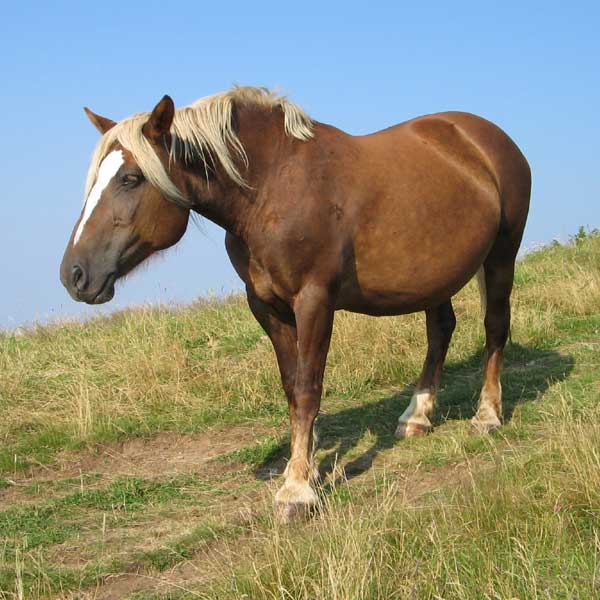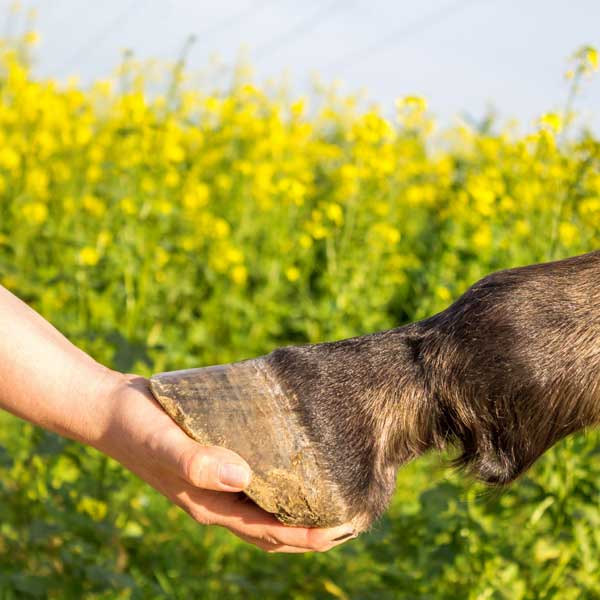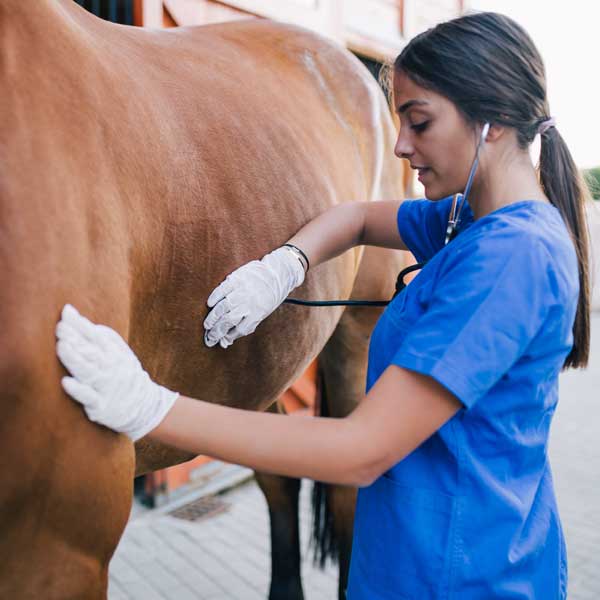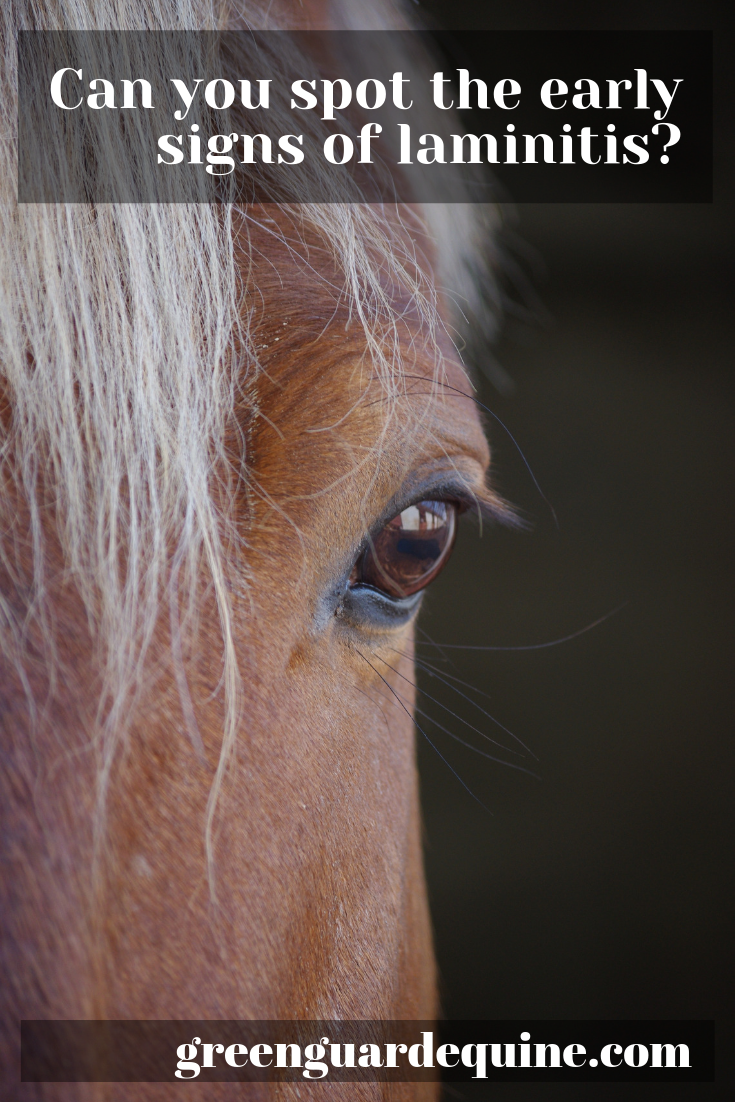Laminitis is a potentially fatal and maddeningly-sneaky medical condition affecting the feet of horses. There are three major reasons why we refer to laminitis as a “sneaky” disease:
- Laminitis is a secondary condition with vague symptoms.
- As a secondary condition, it has a bewildering range of causes.
- Development is erratic and flare-ups are unpredictable.
When a horse develops laminitis, the signs are often subtle. Since laminitis can arise from any number of underlying causes, it can also be difficult to pinpoint and diagnose. One of its most insidious features is its unpredictability. While overindulging on lush, sweet spring grass is a notable trigger, a laminitic episode can strike a horse at any time of year.
Your veterinarian should always be your first call when you detect any sign of a hoof issue. At the very least, taking this precaution can rule out laminitis. For horses that receive a positive diagnosis for laminitis, your veterinarian’s early arrival gives your horse the best chance for recovery. The purpose of this piece is to equip you with all the lay knowledge you need to spot the early signs of a laminitic episode. You are your horse’s first line of defense against needless suffering!

Equine laminitis episodes tend to occur 20-72 hours after a trigger event. Photo by D. Uzunov on Shutterstock.
Timing is everything
A laminitic episode generally occurs sometime between 20 and 72 hours after a trigger event. This trigger might be an injury, for instance, or a metabolic condition that sets off an insulin chain reaction. It could also be related to an overload of starches or non-soluble carbohydrates in a horse’s feed, forage, or grazing grass. We have previously gone into some depth on these particular causes of equine laminitis. Suffice it to say part of the problem when it comes to isolating the causes of laminitis is that there are so many.
Prior to a laminitic flare up, it’s entirely likely that your horse will not show any obvious or startling signs of laminitis. We have to look for subtler signs. There are symptoms just beneath the surface that you might be able to pick up on before your horse becomes visibly and severely lame.
Sense of touch: signs of laminitis that you can feel
Get in the habit of taking your horse’s digital pulse. Similar to the method of placing a finger on a human wrist, a horse’s digital pulse can be taken near the fetlock joint toward the base of a horse’s front leg. The easiest way to know if something is going wrong in the hoof area is an increase or quickening of the digital pulse.
Most horses have a non-existent or barely-perceptible pulse, but a horse with a hoof issue will have a much more noticeable digital pulse. You might hear the word “bounding” to describe a strong, tangible digital pulse. This often indicates that a horse is dealing with an episode of laminitis or some other hoof-health emergency.
An increase in your horse’s resting heart rate is another detectable symptom of laminitis. A horse that is starting to develop laminitis will have a resting heart rate that is five or six beats faster than normal. You don’t have to be a doctor or a veterinarian to buy a stethoscope, and your equine veterinarian should be happy to teach you to use it. You can also measure a horse’s resting heart rate by resting a finger on the facial, or mandibular, artery.
Habitual and regular observation of a horse’s hooves
Heat in the hoof is somewhat less reliable of a guidepost, but it can be useful if you get into the habit of checking it regularly. This is a fairly subjective measurement, and can be influenced by your horse standing in the sun. However, as you start to get a sense of how warm or cool your horse’s hooves are naturally, you will be better able to gauge what feels normal and when it feels like there may be excessive heat present.
Learn to read the rings around your horse’s hooves. Normal hoof growth in horses tends to favor the toe, or front-facing, side. Horses that are likely to have laminitis will start to grow more heel. The clearest sign of abnormal hoof growth is that distorted rings begin to appear on the hooves.

Become familiar with the countours of your horse's hooves. Photo by lamiafotografia on Shutterstock
. One major benefit of learning to read hoof rings and their growth patterns is that this is the earliest detectable symptom of laminitis. Distorted rings and distended heel growth can appear weeks or months -- even years -- before a case of laminitis is properly diagnosed. Your fingers can usually trace these rings around the hoof from toe to heel.
By sight: signs of laminitis can you see?
You and your farrier might start to notice changes in the white line of your horse. The white line is the cream-colored area on the base of a horse’s foot where the sole and hoof wall meet. There might be bruising, blood stains, or separation that can indicate laminitis. The easiest time to see these changes is when the hoof is freshly trimmed and rasped.
A horse’s body language doesn’t lie. You might be able to pick up on a few things that your horse does, or doesn’t do, that will alert you to laminitis. Many of these early signs of laminitis are based on nothing more than careful and regular observation of your horse’s habits and tendencies. Changes in a horse’s body posture and habits include:
- Altered stance and unusual resting positions
- Repetitive and awkward turning in the stall
- Shorter strides
- Leaning backward
- Acting colicky
Your horse’s stance and how he rests his legs can be telling. You might see extra weight shifting from leg to leg. Alternately, you may observe that your horse starts firmly rooting himself, unwilling to shift his weight at all. Another variation is seeing your horse resting for unusual amounts of time and doing so during strange times of the day.
The way your horse turns in his stall or a small space may also betray the early stages of laminitis. A general reluctance to turning, taking tiny, ginger steps to turn, and shifting a lot of weight to the hindquarters to make turns can tell you that the weight on a horse’s front hooves is painful for them.
Even when a horse is walking in a straight line, you can see some of the slighter and less noticeable signs of laminitis. The forward strides a horse makes will be shorter and choppier, and there may be some hesitation when the ground changes. Something as simple as moving from soft ground or a matted stall on to firmer ground or pavement can become a source of stress for a horse in the early stages of a laminitic episode.

A horse that turns or rests awkwardly in his stall may be suffering from laminitis. Photo by Wadim Wall on Shutterstock.
As laminitis progresses, clearer signs emerge. Historically, the clearest physical symptom of laminitis is you will find that, especially while standing stationary, your horse will lean back on the hindquarters and send his front legs out to relieve some weight on the front hooves.
You also might notice your horse is acting like he has colic. In an attempt to get comfortable, horses with laminitis often look strikingly similar to a horse with colic. These signs include restless pawing at the ground, awkward stretching, and rolling, or attempting to roll, on the ground. In either case - call your veterinarian right away.
Laminitis prone: is your horse at risk?
It can be very helpful to know if your horse is laminitis prone or at a higher risk for developing laminitis. There are many circumstances that are within your power to change, control, or at least manage. These include:
- Weight management
- Metabolic disorders
- History of or genetic predisposition toward laminitis
Excess weight is a major controllable factor. A fat, overweight, or obese horse puts more strain on his hooves. His joints also have to work harder to support the excess weight. Over time, this can mechanically strain the hooves and laminae.
Metabolic disorders are more common in overweight horses. The increase in insulin and/or cortisol in these scenarios creates the ideal conditions for laminitis to take hold. Your equine vet can perform simple blood tests that will reveal metabolic disorders long before the classic symptoms appear.

Your equine vet can run tests to discover metabolic disorders. Photo by Hedgehog94 on Shutterstock
. Finally, your horse may be at higher risk for laminitis if they’ve endured previous laminitic episodes, have a history of recurrent abscesses, or have poor hoof conformation. If you’ve recently gotten your horse, make sure their health history is transferred to your current veterinarian.
Learning the early signs can help your horse!
Once you spot a sign or symptom of laminitis, or discover that your horse’s digital pulse is increased, your first call should be to your equine veterinarian. Don’t wait a moment! Early intervention is key. The sooner a diagnosis is made and a case confirmed, the sooner you, your vet, and your farrier can begin to map out a course of preventive care and treatment.
The ultimate goal when looking into the early signs of laminitis is to provide pain relief as well as disrupt the inflammatory response so that bones don’t start to shift and drop inside the hoof. If laminitis is allowed to play out, the consequences can be severe, costly, or even fatal.
Liv Gude is the founder of Pro Equine Grooms.






